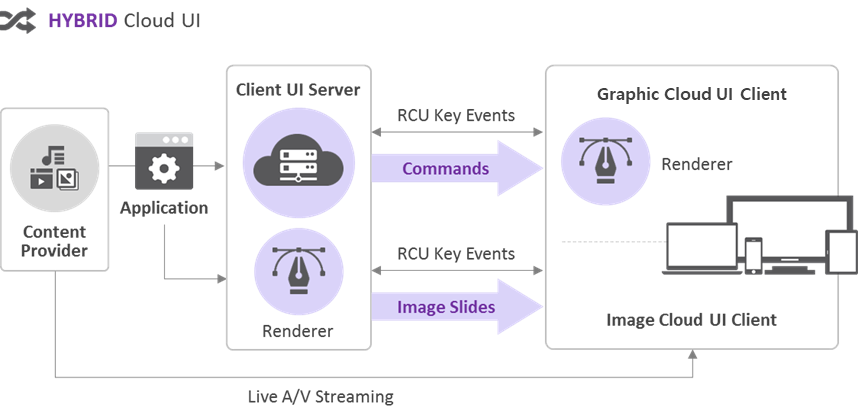User Experience Provisions Using Cloud Technology
Jaeyoon Lee
Team Lead/Service Platform Dept., Altimedia Corp.
The term "cloud" began to become popular from the point when various connected devices appeared and network speeds above a certain level began to be secured. With the emergence of services that can store data in virtual spaces on the network rather than local storage on PCs, not only the IT industry but also the general public have become familiar with the word “cloud”. Now, as almost all service platforms adopt the concept of cloud, it has become an inseparable technology from real life.
The cloud described in this article is also similar with the concept in which the service operates in a virtual environment. However, it focuses more on how the user experience in media services can be provided on the concept of cloud.
Pay-TV services, a major supplier of media services, are provided through dedicated terminal devices(set-top boxes) manufactured to meet the needs of each operator. Set-top boxes are based on specialized hardware to provide broadcast services, and have specialized functions such as channel selection, broadcast signal reception, video/audio playback control, and various data transmission and reception. On the other hand, they have relatively low computational and storage capabilities. Therefore, it has a very low cost structure compared to other devices such as mobile phones, and the replacement cycle is quite long due to its limited usability.
As a result, Pay-TV operators must consider low-spec set-top boxes already installed in the field when developing new functions or upgrading services. Of course, it is not desirable (although technically possible) to provide the same service on HD terminals five years after installation and the latest UHD terminals. Therefore, it was a common approach to create and operate services that could operate optimally in each set-top box separately.
The problem was the cost. As the speed of development of technologies and services increased, the maintenance cost of terminals and services to accommodate them also raised significantly. Whenever high-end set-top boxes were developed and new platforms such as Android were added, operators had no choice but to create service applications accordingly. Moreover, the difficulty of maintenance had dramatically increased for suppliers due to the fragmentation of services.
However, these concerns were solved by incorporating cloud technology into the user experience of media services. Since the service basically operates in the cloud environment and the set-top box has a structure that only handles display processing, it is possible to eliminate or minimize dependence on terminal hardware from the service standpoint. We collectively refer to these technologies and services as 'Cloud UI'.
The cloud UI is based on virtualization technology for the service platform and is divided into three approaches according to the UI delivery method as below.
• First, a Video Cloud Solution (VCS) that delivers service screens in a video manner.
• Second, Image Cloud Solution (ICS) that delivers service screens in an image manner.
• Third, Graphic Cloud Solution (GCS) that delivers the results of the operation constituting the service screen in the form of commands which are easily processed by the terminal.
VCS and ICS services are created in the form of web applications running on a typical web browser. GCS, in general, should consider both the ease of service development and the efficiency of platform operation. For this, Altimedia has a solution that supports services written in JavaScript based on Node JS.
Looking at the characteristics of each solution, first of all, VCS sends a video-based screen drawn by the browser, so the data transmitted from the server is large. Also, the video needs to be encoded and transmitted, so it has to allocate as much resources as server CPU or memory. Therefore, while the performance that one server can handle is inevitably less than that of ICS and GCS, there is no limit to the UI that can be expressed as much as video is transmitted.
ICS transmits the screen drawn by the browser in an image method, therefore less data is transmitted than VCS and less server resources are consumed than video. However, assuming that an application with fancy animations is serviced, it cannot express a smooth screen naturally as much as VCS.
Whereas VCS and ICS transmit the screen itself to the user, GCS sends the command that the set-top box should draw and the client in the set-top box draws directly on the screen based on the command. Therefore, the data transmitted is significantly reduced compared to VCS and ICS, and the cloud system can be built in most economical way. However, since the final drawing process is to be performed in the set-top box, there may be a difference in performance depending on the hardware specification.
The figure below is a diagram of a hybrid cloud UI system that uses GCS and ICS together. By developing the main menu frequently used by most users with GCS, many user requests can be processed at a low cost. Also, various web applications can be easily provided by applying ICS for individual services with intermittent requests. The Cloud UI system can be most efficient by building a combination of the above three methods in consideration of the characteristics of the service, necessary performance, and economic feasibility.
The game industry has been actively using cloud technology since early on. The widely known Steam and Stadia, which were unveiled on Google a few years ago, are also using cloud technology to provide spectacular games comparable to console games such as PlayStation and XBox. With the development of virtualization technology and the improvement of the speed of wired and wireless networks, the provision of services using cloud technology is expected to become more common. In the very near future, we expect to have a cellphone being used as a laptop simply with Windows installed on the server.


